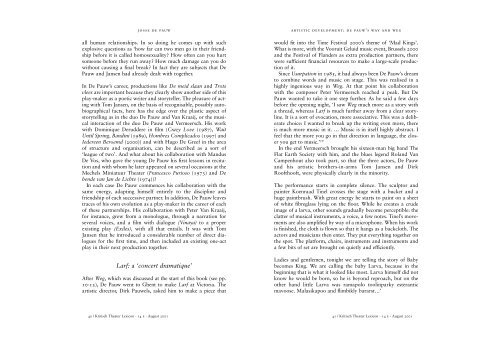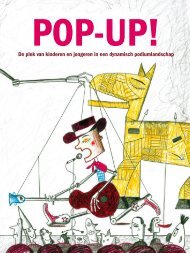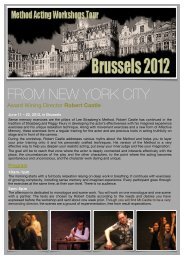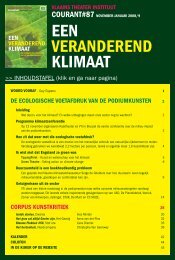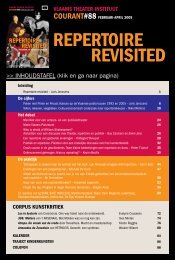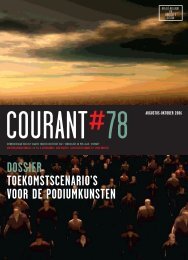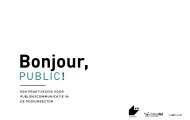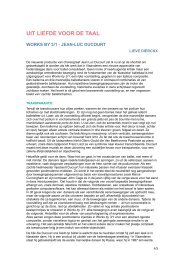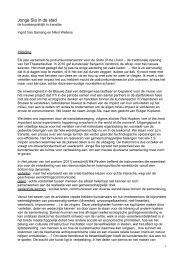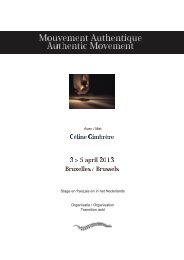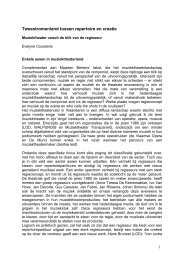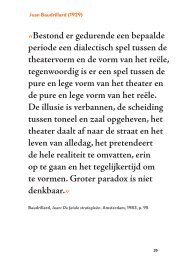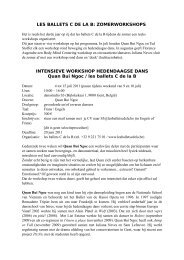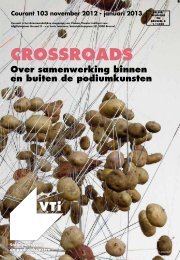Create successful ePaper yourself
Turn your PDF publications into a flip-book with our unique Google optimized e-Paper software.
josse de pauw<br />
all human relationships. In so doing he comes up with such<br />
explosive questions as ‘how far can two men go in their friendship<br />
before it is called homosexuality? How often can you hurt<br />
someone before they run away? How much damage can you do<br />
without causing a final break? In fact they are subjects that <strong>De</strong><br />
<strong>Pauw</strong> and Jansen had already dealt with together.<br />
In <strong>De</strong> <strong>Pauw</strong>’s career, productions like <strong>De</strong> meid slaan and Trots<br />
vlees are important because they clearly show another side of this<br />
play-maker as a poetic writer and storyteller. The pleasure of acting<br />
with Tom Jansen, on the basis of recognisable, possibly autobiographical<br />
facts, here has the edge over the plastic aspect of<br />
storytelling as in the duo <strong>De</strong> <strong>Pauw</strong> and Van Kraaij, or the musical<br />
interaction of the duo <strong>De</strong> <strong>Pauw</strong> and Vermeersch. His work<br />
with Dominique <strong>De</strong>ruddere in film (Crazy Love (1987), Wait<br />
Until Spring, Bandini (1989), Hombres Complicados (1997) and<br />
Iedereen Beroemd (2000)) and with Hugo <strong>De</strong> Greef in the area<br />
of structure and organisation, can be described as a sort of<br />
‘league of two’. And what about his collaboration with Mandus<br />
<strong>De</strong> Vos, who gave the young <strong>De</strong> <strong>Pauw</strong> his first lessons in recitation<br />
and with whom he later appeared on several occasions at the<br />
Mechels Miniatuur Theater (Francesco Furioso (1973) and <strong>De</strong><br />
bende van Jan de Lichte (1974))?<br />
In each case <strong>De</strong> <strong>Pauw</strong> commences his collaboration with the<br />
same energy, adapting himself entirely to the discipline and<br />
friendship of each successive partner. In addition, <strong>De</strong> <strong>Pauw</strong> leaves<br />
traces of his own evolution as a play-maker in the career of each<br />
of these partnerships. His collaboration with Peter Van Kraaij,<br />
for instance, grew from a monologue, through a narration for<br />
several voices, and a film with dialogue (Vinaya) to a proper<br />
existing play (Exiles), with all that entails. It was with Tom<br />
Jansen that he introduced a considerable number of direct dialogues<br />
for the first time, and then included an existing one-act<br />
play in their next production together.<br />
Larf: a ‘concert dramatique’<br />
After Weg, which was discussed at the start of this book (see pp.<br />
10-12), <strong>De</strong> <strong>Pauw</strong> went to Ghent to make Larf at Victoria. The<br />
artistic director, Dirk <strong>Pauw</strong>els, asked him to make a piece that<br />
40 / Kritisch Theater Lexicon - 14 e - August 2001<br />
artistic development: de pauw’s way and weg<br />
would fit into the Time Festival 2000’s theme of ‘Mad Kings’.<br />
What is more, with the Vooruit Geluid music event, Brussels 2000<br />
and the Festival of Flanders as extra production partners, there<br />
were sufficient financial resources to make a large-scale production<br />
of it.<br />
Since Usurpation in 1985, it had always been <strong>De</strong> <strong>Pauw</strong>’s dream<br />
to combine words and music on stage. This was realised in a<br />
highly ingenious way in Weg. At that point his collaboration<br />
with the composer Peter Vermeersch reached a peak. But <strong>De</strong><br />
<strong>Pauw</strong> wanted to take it one step further. As he said a few days<br />
before the opening night, ‘I saw Weg much more as a story with<br />
a thread, whereas Larf is much further away from a clear storyline.<br />
It is a sort of evocation, more associative. This was a deliberate<br />
choice: I wanted to break up the writing even more, there<br />
is much more music in it. … Music is in itself highly abstract. I<br />
feel that the more you go in that direction in language, the closer<br />
you get to music.’ 19<br />
In the end Vermeersch brought his sixteen-man big band The<br />
Flat Earth Society with him, and the blues legend Roland Van<br />
Campenhout also took part, so that the three actors, <strong>De</strong> <strong>Pauw</strong><br />
and his artistic brothers-in-arms Tom Jansen and Dirk<br />
Roofthooft, were physically clearly in the minority.<br />
The performance starts in complete silence. The sculptor and<br />
painter Koenraad Tinel crosses the stage with a bucket and a<br />
huge paintbrush. With great energy he starts to paint on a sheet<br />
of white fibreglass lying on the floor. While he creates a crude<br />
image of a larva, other sounds gradually become perceptible: the<br />
clatter of musical instruments, a voice, a few notes. Tinel’s movements<br />
are also amplified by way of a microphone. When his work<br />
is finished, the cloth is flown so that it hangs as a backcloth. The<br />
actors and musicians then enter. They put everything together on<br />
the spot. The platform, chairs, instruments and instruments and<br />
a few bits of set are brought on quietly and efficiently.<br />
Ladies and gentlemen, tonight we are telling the story of Baby<br />
becomes King. We are calling the baby Larva, because in the<br />
beginning that is what it looked like most. Larva himself did not<br />
know he would be born, so he is beyond reproach, but on the<br />
other hand little Larva was ramapolo toolinparky esterantic<br />
mavoose. Malasikapoo and flimbikly bararst…’<br />
41 / Kritisch Theater Lexicon - 14 e - August 2001


